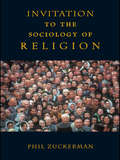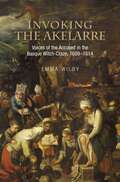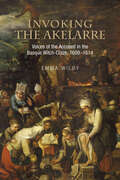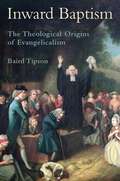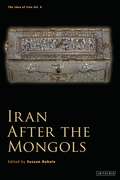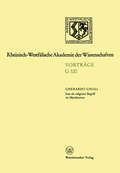- Table View
- List View
Invitation to the Sociology of Religion
by Phil ZuckermanThis book intends to serve as a conversational, colorful, engaging, and provocative introduction to the sociology of religion for undergraduates. Written in lively prose, this volume aims to introduce students to the major themes, problems and goals of the sociological study of religion while also summoning the sense of wonder and curiosity for the enterprise itself.
Invitation to the Sociology of Religion
by Phil ZuckermanThis book intends to serve as a conversational, colorful, engaging, and provocative introduction to the sociology of religion for undergraduates. Written in lively prose, this volume aims to introduce students to the major themes, problems and goals of the sociological study of religion while also summoning the sense of wonder and curiosity for the enterprise itself.
Invitation to World Religions
by Jeffrey BroddFeaturing a unique, consistent, and modular chapter structure--"Teachings," "History," and "Way of Life"--and numerous pedagogical features, Invitation to World Religions invites students to explore the world's great religions with respect and a sense of wonder. This chapter structure enables students to navigate each religion in a consistent and systematic way and helps students to make comparisons between religions. The book describes the essential features of each religion and shows how they have responded to basic human needs and to the cultural contexts in which they developed. The authors also encourage students to develop an appreciation for what religious beliefs and practices actually mean to their adherents.
Invitation to World Religions
by Jeffrey BroddFeaturing a unique, consistent, and modular chapter structure--"Teachings," "History," and "Way of Life"--and numerous pedagogical features, Invitation to World Religions invites students to explore the world's great religions with respect and a sense of wonder. This chapter structure enables students to navigate each religion in a consistent and systematic way and helps students to make comparisons between religions. The book describes the essential features of each religion and shows how they have responded to basic human needs and to the cultural contexts in which they developed. The authors also encourage students to develop an appreciation for what religious beliefs and practices actually mean to their adherents.
Inviting Gods Presence
by Larry KeefauverKeefauver believes that the passionate pursuit of God is the most authentic method of finding God's presence in our lives. Divided in two parts, this volume is a journey into developing a genuine relationship with God.
Invoking the Akelarre: Voices of the Accused in the Basque Witch-Craze, 1609-1614
by Emma WilbyWith their dramatic descriptions of black masses and cannibalistic feasts, the records generated by the Basque witch-craze of 160914 provide us with arguably the most demonologically-stereotypical accounts of the witches sabbath or akelarre to have emerged from early modern Europe. While the trials have attracted scholarly attention, the most substantial monograph on the subject was written nearly forty years ago and most works have focused on the ways in which interrogators shaped the pattern of prosecutions and the testimonies of defendants. Invoking the Akelarre diverts from this norm by employing more recent historiographical paradigms to analyze the contributions of the accused. Through interdisciplinary analyses of both French- and Spanish-Basque records, it argues that suspects were not passive recipients of elite demonological stereotypes but animated these received templates with their own belief and experience, from the dark exoticism of magical conjuration, liturgical cursing and theatrical misrule to the sharp pragmatism of domestic medical practice and everyday religious observance. In highlighting the range of raw materials available to the suspects, the book helps us to understand how the fiction of the witches sabbath emerged to such prominence in contemporary mentalities, whilst also restoring some agency to the defendants and nuancing the historical thesis that stereotypical content points to interrogatorial opinion and folkloric content to the voices of the accused. In its local context, this study provides an intimate portrait of peasant communities as they flourished in the Basque region in this period and leaves us with the irony that Europes most sensationally-demonological accounts of the witches sabbath may have evolved out of a particularly ardent commitment, on the part of ordinary Basques, to the social and devotional structures of popular Catholicism.
Invoking the Akelarre: Voices of the Accused in the Basque Witch-Craze, 1609-1614
by Emma WilbyWith their dramatic descriptions of black masses and cannibalistic feasts, the records generated by the Basque witch-craze of 160914 provide us with arguably the most demonologically-stereotypical accounts of the witches sabbath or akelarre to have emerged from early modern Europe. While the trials have attracted scholarly attention, the most substantial monograph on the subject was written nearly forty years ago and most works have focused on the ways in which interrogators shaped the pattern of prosecutions and the testimonies of defendants. Invoking the Akelarre diverts from this norm by employing more recent historiographical paradigms to analyze the contributions of the accused. Through interdisciplinary analyses of both French- and Spanish-Basque records, it argues that suspects were not passive recipients of elite demonological stereotypes but animated these received templates with their own belief and experience, from the dark exoticism of magical conjuration, liturgical cursing and theatrical misrule to the sharp pragmatism of domestic medical practice and everyday religious observance. In highlighting the range of raw materials available to the suspects, the book helps us to understand how the fiction of the witches sabbath emerged to such prominence in contemporary mentalities, whilst also restoring some agency to the defendants and nuancing the historical thesis that stereotypical content points to interrogatorial opinion and folkloric content to the voices of the accused. In its local context, this study provides an intimate portrait of peasant communities as they flourished in the Basque region in this period and leaves us with the irony that Europes most sensationally-demonological accounts of the witches sabbath may have evolved out of a particularly ardent commitment, on the part of ordinary Basques, to the social and devotional structures of popular Catholicism.
Inward: Vipassana Meditation and the Embodiment of the Self (Fieldwork Encounters and Discoveries)
by Michal PagisWestern society has never been more interested in interiority. Indeed, it seems more and more people are deliberately looking inward—toward the mind, the body, or both. Michal Pagis’s Inward focuses on one increasingly popular channel for the introverted gaze: vipassana meditation, which has spread from Burma to more than forty countries and counting. Lacing her account with vivid anecdotes and personal stories, Pagis turns our attention not only to the practice of vipassana but to the communities that have sprung up around it. Inward is also a social history of the westward diffusion of Eastern religious practices spurred on by the lingering effects of the British colonial presence in India. At the same time Pagis asks knotty questions about what happens when we continually turn inward, as she investigates the complex relations between physical selves, emotional selves, and our larger social worlds. Her book sheds new light on evergreen topics such as globalization, social psychology, and the place of the human body in the enduring process of self-awareness.
Inward: Vipassana Meditation and the Embodiment of the Self (Fieldwork Encounters and Discoveries)
by Michal PagisWestern society has never been more interested in interiority. Indeed, it seems more and more people are deliberately looking inward—toward the mind, the body, or both. Michal Pagis’s Inward focuses on one increasingly popular channel for the introverted gaze: vipassana meditation, which has spread from Burma to more than forty countries and counting. Lacing her account with vivid anecdotes and personal stories, Pagis turns our attention not only to the practice of vipassana but to the communities that have sprung up around it. Inward is also a social history of the westward diffusion of Eastern religious practices spurred on by the lingering effects of the British colonial presence in India. At the same time Pagis asks knotty questions about what happens when we continually turn inward, as she investigates the complex relations between physical selves, emotional selves, and our larger social worlds. Her book sheds new light on evergreen topics such as globalization, social psychology, and the place of the human body in the enduring process of self-awareness.
Inward: Vipassana Meditation and the Embodiment of the Self (Fieldwork Encounters and Discoveries)
by Michal PagisWestern society has never been more interested in interiority. Indeed, it seems more and more people are deliberately looking inward—toward the mind, the body, or both. Michal Pagis’s Inward focuses on one increasingly popular channel for the introverted gaze: vipassana meditation, which has spread from Burma to more than forty countries and counting. Lacing her account with vivid anecdotes and personal stories, Pagis turns our attention not only to the practice of vipassana but to the communities that have sprung up around it. Inward is also a social history of the westward diffusion of Eastern religious practices spurred on by the lingering effects of the British colonial presence in India. At the same time Pagis asks knotty questions about what happens when we continually turn inward, as she investigates the complex relations between physical selves, emotional selves, and our larger social worlds. Her book sheds new light on evergreen topics such as globalization, social psychology, and the place of the human body in the enduring process of self-awareness.
Inward: Vipassana Meditation and the Embodiment of the Self (Fieldwork Encounters and Discoveries)
by Michal PagisWestern society has never been more interested in interiority. Indeed, it seems more and more people are deliberately looking inward—toward the mind, the body, or both. Michal Pagis’s Inward focuses on one increasingly popular channel for the introverted gaze: vipassana meditation, which has spread from Burma to more than forty countries and counting. Lacing her account with vivid anecdotes and personal stories, Pagis turns our attention not only to the practice of vipassana but to the communities that have sprung up around it. Inward is also a social history of the westward diffusion of Eastern religious practices spurred on by the lingering effects of the British colonial presence in India. At the same time Pagis asks knotty questions about what happens when we continually turn inward, as she investigates the complex relations between physical selves, emotional selves, and our larger social worlds. Her book sheds new light on evergreen topics such as globalization, social psychology, and the place of the human body in the enduring process of self-awareness.
Inward: Vipassana Meditation and the Embodiment of the Self (Fieldwork Encounters and Discoveries)
by Michal PagisWestern society has never been more interested in interiority. Indeed, it seems more and more people are deliberately looking inward—toward the mind, the body, or both. Michal Pagis’s Inward focuses on one increasingly popular channel for the introverted gaze: vipassana meditation, which has spread from Burma to more than forty countries and counting. Lacing her account with vivid anecdotes and personal stories, Pagis turns our attention not only to the practice of vipassana but to the communities that have sprung up around it. Inward is also a social history of the westward diffusion of Eastern religious practices spurred on by the lingering effects of the British colonial presence in India. At the same time Pagis asks knotty questions about what happens when we continually turn inward, as she investigates the complex relations between physical selves, emotional selves, and our larger social worlds. Her book sheds new light on evergreen topics such as globalization, social psychology, and the place of the human body in the enduring process of self-awareness.
Inward: Vipassana Meditation and the Embodiment of the Self (Fieldwork Encounters and Discoveries)
by Michal PagisWestern society has never been more interested in interiority. Indeed, it seems more and more people are deliberately looking inward—toward the mind, the body, or both. Michal Pagis’s Inward focuses on one increasingly popular channel for the introverted gaze: vipassana meditation, which has spread from Burma to more than forty countries and counting. Lacing her account with vivid anecdotes and personal stories, Pagis turns our attention not only to the practice of vipassana but to the communities that have sprung up around it. Inward is also a social history of the westward diffusion of Eastern religious practices spurred on by the lingering effects of the British colonial presence in India. At the same time Pagis asks knotty questions about what happens when we continually turn inward, as she investigates the complex relations between physical selves, emotional selves, and our larger social worlds. Her book sheds new light on evergreen topics such as globalization, social psychology, and the place of the human body in the enduring process of self-awareness.
Inward Baptism: The Theological Origins of Evangelicalism
by Baird TipsonInward Baptism analyses the theological developments that led to the great evangelical revivals of the mid-eighteenth century. Baird Tipson here demonstrates how the rationale for the "new birth," the characteristic and indispensable evangelical experience, developed slowly but inevitably from Luther's critique of late medieval Christianity. Addressing the great indulgence campaigns of the late fifteenth and early sixteenth centuries, Luther's perspective on sacramental baptism, as well as the confrontation between Lutheran and Reformed theologians who fastened on to different aspects of Luther's teaching, Tipson sheds light on how these disparate historical moments collectively created space for evangelicalism. This leads to an exploration of the theology of the leaders of the Evangelical awakening in the British Isles, George Whitefield and John Wesley, who insisted that by preaching the immediate revelation of the Holy Spirit during the "new birth," they were recovering an essential element of primitive Christianity that had been forgotten over the centuries. Ultimately, Inward Baptism examines how these shifts in religious thought made possible a commitment to an inward baptism and consequently, the evangelical experience.
Inward Baptism: The Theological Origins of Evangelicalism
by Baird TipsonInward Baptism analyses the theological developments that led to the great evangelical revivals of the mid-eighteenth century. Baird Tipson here demonstrates how the rationale for the "new birth," the characteristic and indispensable evangelical experience, developed slowly but inevitably from Luther's critique of late medieval Christianity. Addressing the great indulgence campaigns of the late fifteenth and early sixteenth centuries, Luther's perspective on sacramental baptism, as well as the confrontation between Lutheran and Reformed theologians who fastened on to different aspects of Luther's teaching, Tipson sheds light on how these disparate historical moments collectively created space for evangelicalism. This leads to an exploration of the theology of the leaders of the Evangelical awakening in the British Isles, George Whitefield and John Wesley, who insisted that by preaching the immediate revelation of the Holy Spirit during the "new birth," they were recovering an essential element of primitive Christianity that had been forgotten over the centuries. Ultimately, Inward Baptism examines how these shifts in religious thought made possible a commitment to an inward baptism and consequently, the evangelical experience.
Ir-rev-rend: Christianity Without the Pretense. Faith Without the Façade
by Greg SurrattIr-rev-rend (ir REV rund) noun1. a pastor who is somewhat critical of what is generally accepted or respected2. a pastor who is trying to make sense of life, love, the church and other confusing things from a slightly satirical point of view; an irreverent sense of humor.3. a "normal" guy pursuing GodWhatever you may think about the "typical" pastor, throw it out. Do they make bad decisions? Yes. Commit sin and experience severed relationships? Yes and yes. Pastor Greg Surratt is not perfect, and he unashamedly tells the stories that have strengthened his faith. He writes that the choice to follow Christ is never clean, is often scary, is usually clothed in mystery, and is always an adventure.For some people, God appears in dark, dirty, lonely, or just plain odd places. Greg found God while huddled under a grand piano, hiding from overzealous friends and family trying to accost him during an altar call at a Pentecostal revival. So began a life of sharing stories of God's endlessly creative and often surprising work and seeing God's transforming power in unexpected ways. Despite years of vocational ministry, Greg never underestimates the power of divine/human encounters in some of teh least "churchy' places on earth.Humorous, insightful, and challenging, IR-REV-REND is a revealing and joyous look at real-life Christian living. As Greg himself affirms, if God can use his missteps and blunders, God can use anybody's.
Iran: From Theocracy to the Green Movement
by Negin NabaviNegin Nabavi brings together essays written by experts and scholars that shed light on the many transformations that Iran has experienced in the thirty years under the Islamic Republic and speculate on the import of the developments of 2009 and beyond.
Iran After the Mongols (The Idea of Iran)
by Sussan BabaieFollowing the devastating Mongol conquest of Baghdad in 1258, the domination of the Abbasids declined leading to successor polities, chiefly among them the Ilkhanate in Greater Iran, Iraq and the Caucasus. Iranian cultural identities were reinstated within the lands that make up today's Iran, including the area of greater Khorasan. The Persian language gained unprecedented currency over Arabic and new buildings and manuscripts were produced for princely patrons with aspirations to don the Iranian crown of kingship. This new volume in “The Idea of Iran” series follows the complexities surrounding the cultural reinvention of Iran after the Mongol invasions, but the book is unique capturing not only the effects of Mongol rule but also the period following the collapse of Mongol-based Ilkhanid rule. By the mid-1330s the Ilkhanate in Iran was succeeded by alternative models of authority and local Iranian dynasties. This led to the proliferation of diverse and competing cultural, religious and political practices but so far scholarship has neglected to produce an analysis of this multifaceted history in any depth. Iran After the Mongols offers new and cutting-edge perspectives on what happened. Analysing the fourteenth century in its own right, Sussan Babaie and her fellow contributors capture the cultural complexity of an era that produced some of the most luminous masterpieces in Persian literature and the most significant new building work in Tabriz, Yazd, Herat and Shiraz. Featuring contributions by leading scholars, this is a wide-ranging treatment of an under-researched period and the volume will be essential reading for scholars of Iranian Studies and Middle Eastern History.
Iran After the Mongols (The Idea of Iran)
Following the devastating Mongol conquest of Baghdad in 1258, the domination of the Abbasids declined leading to successor polities, chiefly among them the Ilkhanate in Greater Iran, Iraq and the Caucasus. Iranian cultural identities were reinstated within the lands that make up today's Iran, including the area of greater Khorasan. The Persian language gained unprecedented currency over Arabic and new buildings and manuscripts were produced for princely patrons with aspirations to don the Iranian crown of kingship. This new volume in “The Idea of Iran” series follows the complexities surrounding the cultural reinvention of Iran after the Mongol invasions, but the book is unique capturing not only the effects of Mongol rule but also the period following the collapse of Mongol-based Ilkhanid rule. By the mid-1330s the Ilkhanate in Iran was succeeded by alternative models of authority and local Iranian dynasties. This led to the proliferation of diverse and competing cultural, religious and political practices but so far scholarship has neglected to produce an analysis of this multifaceted history in any depth. Iran After the Mongols offers new and cutting-edge perspectives on what happened. Analysing the fourteenth century in its own right, Sussan Babaie and her fellow contributors capture the cultural complexity of an era that produced some of the most luminous masterpieces in Persian literature and the most significant new building work in Tabriz, Yazd, Herat and Shiraz. Featuring contributions by leading scholars, this is a wide-ranging treatment of an under-researched period and the volume will be essential reading for scholars of Iranian Studies and Middle Eastern History.
Iran als religiöser Begriff im Mazdaismus: 355. Sitzung am 18. März 1992 in Düsseldorf (Rheinisch-Westfälische Akademie der Wissenschaften #320)
by Gherardo GnoliIran and Christianity: Historical Identity and Present Relevance
by Mark BradleyIn this enlightening study Mark Bradley looks at the growing underground church in Iran. Given the hostility of the regime, it is often assumed that Christianity is withering in Iran, but in fact more Iranian Muslims have become Christians in the last 25 years than since the seventh century, when Islam first came to Iran. Beginning with an in-depth look at the historical identity of Iran, religiously, culturally and politically, Bradley shows how this identity makes Iranians inclined towards Christianity. He goes on to look at the impact of the 1979 revolution, an event which has brought war, economic chaos and totalitarianism to Iran, and its implications for Iranian faith. The study concludes with an analysis of church growth since 1979 and an examination of the emerging underground church. This is a fascinating work, guaranteed to improve any reader's knowledge of not only Iranian faith and church growth, but of Iranian culture and history as a whole thanks to the thorough treatment given to the country's background.
Iran and Christianity: Historical Identity and Present Relevance
by Mark BradleyIn this enlightening study Mark Bradley looks at the growing underground church in Iran. Given the hostility of the regime, it is often assumed that Christianity is withering in Iran, but in fact more Iranian Muslims have become Christians in the last 25 years than since the seventh century, when Islam first came to Iran. Beginning with an in-depth look at the historical identity of Iran, religiously, culturally and politically, Bradley shows how this identity makes Iranians inclined towards Christianity. He goes on to look at the impact of the 1979 revolution, an event which has brought war, economic chaos and totalitarianism to Iran, and its implications for Iranian faith. The study concludes with an analysis of church growth since 1979 and an examination of the emerging underground church. This is a fascinating work, guaranteed to improve any reader's knowledge of not only Iranian faith and church growth, but of Iranian culture and history as a whole thanks to the thorough treatment given to the country's background.
Iran and the Challenge of Diversity: Islamic Fundamentalism, Aryanist Racism, and Democratic Struggles
by Ailreza AsgharzadehThis interrogates the racist construction of Aria and Aryanism in an Iranian context, arguing that these concepts gave the Indo-European speaking Persian ethnic group an advantage over Iran's non-Persian nationalities and communities.
Iran and the Muslim World: Resistance And Revolution
by N. KeddieThis book consists of a series of interrelated chapters analyzing why Iran, among all countries, has seen so many revolutionary movements in the past century; the degree to which its religion, Shi'ism, is revolutionary; and the history of revolutionary and resistance movements in the modern Muslim world. The author stresses historical change, such as the change of Twelver Shi'ism from political quietism to revolutionary opposition, and also previously unnoticed factors in revolution, such as the multi-urban character of all Iran's modern revolutions.
Iran At The Crossroads: Global Relations In A Turbulent Decade
by Miron RezunThe chapters in this book were written by me or solicited from renowned experts to produce a work that anticipated an imminent post- Khomeini period in Iranian history. The first draft was not ready until June 1989, practically coinciding with the death of Khomeini and the tenth anniversary of the Iranian Revolution-an important milestone after a decade of turmoil. The book you are about to read took some time to put together. Based on extensive research, the project was undertaken in early 1988 and ended about the spring of 1990. A sincere debt of gratitude is naturally owed to all of my contributors. But the preparation of any book does not take place in a financial void. My gratitude is especially extended to the academic vice-president of my university, Dr. Robert Burridge, for granting me the seed money from the university's Development Fund. Substantial financial assistance to cover the bulk of the logistical expenses was offered by the Canadian Institute of International Peace and Security in Ottawa and by the Social Sciences and Humanities Research Council of Canada through its program of aid to scholarly conferences.
